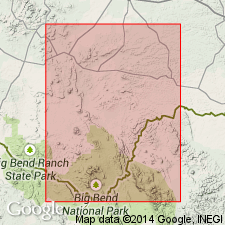
- Usage in publication:
-
- Tornillo clays
- Modifications:
-
- Named
- Dominant lithology:
-
- Clay
- Sandstone
- AAPG geologic province:
-
- Permian basin
Summary:
Named as formation for exposures along Tornillo Creek, southern Brewster Co, TX in the Permian basin. Consists of fine-textured, mostly unfossiliferous, noncalcareous clay throughout with some thin lentils of sandstone. May usually be recognized by peculiar, somber colors: gray, dull olive green, dull blue, dull red, dull yellow, dull purple, dirty brown, and at times, black and white, only occasionally heightened by oxidizing influence of heated intrusives to brighter shades of red and yellow. Sediments considered to have been derived from disintegrated terranes of volcanic origin. Small concretions of carbonate of lime and of iron, usually ranging in size from that of a pea to that of an apple, have a rough exterior and are mostly of a dark or yellow color. In general, the Tornillo clays underlie a circular belt of land just inside that of the Rattlesnake beds (new) surrounding the Chisos Mountains. Thickness at least 800 ft; possibly nearer 1,000 ft. Gradational contact with underlying Rattlesnake beds [currently Aguja Formation] and with overlying Chisos beds (new). Late Cretaceous age.
Source: GNU records (USGS DDS-6; Denver GNULEX).
For more information, please contact Nancy Stamm, Geologic Names Committee Secretary.
Asterisk (*) indicates published by U.S. Geological Survey authors.
"No current usage" (†) implies that a name has been abandoned or has fallen into disuse. Former usage and, if known, replacement name given in parentheses ( ).
Slash (/) indicates name conflicts with nomenclatural guidelines (CSN, 1933; ACSN, 1961, 1970; NACSN, 1983, 2005, 2021). May be explained within brackets ([ ]).

